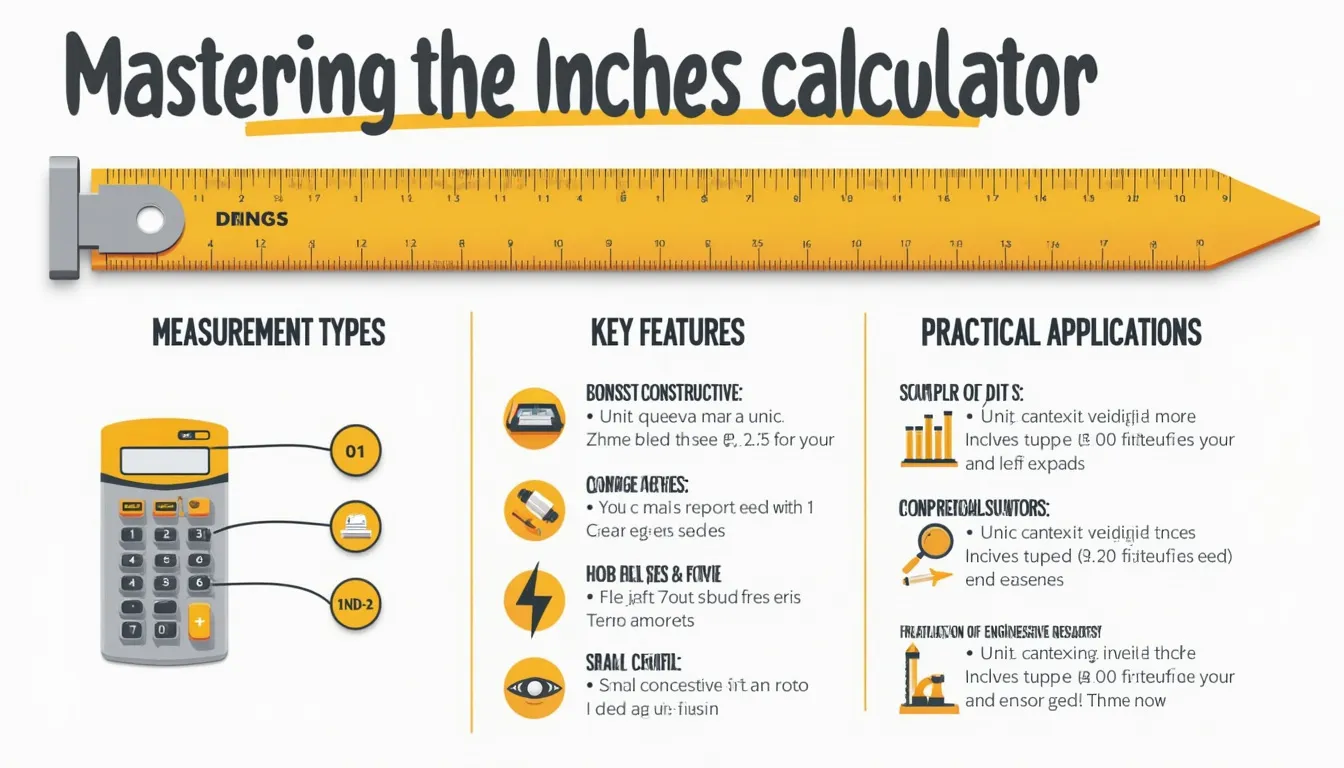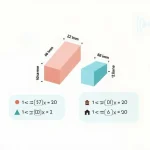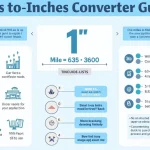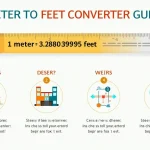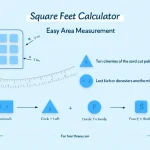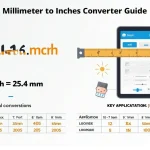Inches Calculator
Is this tool helpful?
How to Use the Inches Calculator Effectively
The Inches Calculator is a versatile tool designed to simplify various measurements and conversions involving inches. Here’s a step-by-step guide on how to use this calculator effectively:
1. Select Measurement Type
Begin by choosing the type of measurement you want to perform:
- Length: For single-dimension measurements
- Area: For two-dimensional measurements
- Volume: For three-dimensional measurements
2. Enter Measurement Values
Depending on the measurement type selected, input the required values:
- Length: Enter a single value in inches (e.g., “5” or “2 1/2”)
- Area: Input both length and width in inches (e.g., “5” for length and “3” for width)
- Volume: Provide length, width, and height in inches (e.g., “5” for length, “3” for width, and “2” for height)
The calculator accepts both decimal and fractional inputs. For fractional inputs, use the format “whole number space fraction” (e.g., “2 1/2”) or just the fraction (e.g., “3/4”).
3. Choose Conversion Unit
Select the unit you want to convert your inch measurement to:
- Centimeters (cm)
- Millimeters (mm)
- Feet (ft)
- Meters (m)
- Yards (yd)
- Miles (mi)
4. Set Fractional Precision
Choose the desired fractional precision for the result:
- 1/16 inch
- 1/32 inch
- 1/64 inch
5. Calculate and View Results
Click the “Calculate” button to process your inputs. The calculator will display:
- The original measurement in inches (both decimal and fractional form)
- The converted measurement in the selected unit
Understanding the Inches Calculator: Definition, Purpose, and Benefits
The Inches Calculator is a comprehensive online tool designed to perform various calculations and conversions related to measurements in inches. Its primary purpose is to simplify and streamline tasks involving length, area, and volume measurements, particularly when working with the imperial system of units.
Key Features and Capabilities
- Converts between inches and other common units of measurement
- Handles both decimal and fractional inch inputs
- Performs calculations for length, area, and volume
- Provides results in both decimal and fractional formats
- Offers adjustable fractional precision for output
Benefits of Using the Inches Calculator
- Time-saving: Eliminates the need for manual calculations, reducing the time spent on measurement conversions and computations.
- Accuracy: Minimizes human error in calculations, ensuring precise results for various measurement tasks.
- Versatility: Accommodates different measurement types (length, area, volume) and multiple unit conversions in a single tool.
- User-friendly: Intuitive interface makes it easy for both professionals and hobbyists to use without extensive training.
- Flexibility: Accepts both decimal and fractional inputs, catering to different measurement preferences and standards.
- Educational value: Helps users understand the relationships between different units of measurement and fractional representations.
How the Inches Calculator Addresses User Needs and Solves Specific Problems
The Inches Calculator is designed to address a wide range of user needs and solve specific problems related to measurements and conversions. Let’s explore some common scenarios where this tool proves invaluable:
1. Construction and Carpentry
For professionals in construction and carpentry, precise measurements are crucial. The Inches Calculator helps by:
- Converting between fractional and decimal inches for accurate material cutting
- Calculating areas for flooring or wall coverage
- Determining volumes for concrete pouring or material estimation
Example Calculation: A carpenter needs to determine the area of a rectangular room for flooring. The room measures 12 feet 6 inches by 10 feet 3 inches.
$$\text{Length} = 12\text{ ft } 6\text{ in} = 150\text{ in}$$ $$\text{Width} = 10\text{ ft } 3\text{ in} = 123\text{ in}$$ $$\text{Area} = 150\text{ in} \times 123\text{ in} = 18,450\text{ sq in}$$Using the Inches Calculator:
- Select “Area” as the measurement type
- Enter “150” for length and “123” for width
- Choose “Square Feet” as the conversion unit
- Click “Calculate”
The calculator will show:
- Area in square inches: 18,450 sq in
- Converted area: 128.125 sq ft
2. DIY and Home Improvement
DIY enthusiasts and homeowners often encounter measurement challenges. The Inches Calculator assists by:
- Simplifying unit conversions for international product specifications
- Helping calculate material quantities for projects
- Assisting in furniture placement and room layout planning
Example Calculation: A DIY enthusiast wants to determine if a bookshelf measuring 72 inches in height will fit in a room with a ceiling height of 2.4 meters.
Using the Inches Calculator:
- Select “Length” as the measurement type
- Enter “72” in the length field
- Choose “Meters” as the conversion unit
- Click “Calculate”
The calculator will show:
- Length in inches: 72 in (6 ft)
- Converted length: 1.8288 m
This result shows that the bookshelf will fit with approximately 0.5712 m (22.5 inches) of clearance.
3. Engineering and Technical Design
Engineers and designers often work with precise measurements. The Inches Calculator helps by:
- Facilitating quick conversions between metric and imperial units
- Assisting in volume calculations for component design
- Providing fractional representations for manufacturing specifications
Example Calculation: An engineer needs to calculate the volume of a cylindrical tank with a diameter of 36 inches and a height of 48 inches.
$$\text{Volume} = \pi r^2 h$$ $$r = 18\text{ in} \text{ (radius is half the diameter)}$$ $$\text{Volume} = \pi \times 18^2 \times 48 = 48,857.14\text{ cubic inches (approx.)}$$Using the Inches Calculator:
- Select “Volume” as the measurement type
- Enter “36” for length (diameter), “36” for width (diameter), and “48” for height
- Choose “Cubic Feet” as the conversion unit
- Click “Calculate”
The calculator will show:
- Volume in cubic inches: 62,208 cu in
- Converted volume: 36 cu ft
Note: The calculator uses a rectangular prism for volume, so the result differs from the cylindrical volume. For precise cylindrical calculations, additional steps would be needed.
Practical Applications and Use Cases
The Inches Calculator finds applications across various fields and everyday scenarios. Here are some practical use cases:
1. Interior Design and Space Planning
- Calculating room dimensions and floor areas
- Determining furniture placement and fit
- Estimating material quantities for flooring, wallpaper, or paint
2. Woodworking and Crafting
- Converting between fractional and decimal measurements for precise cuts
- Calculating board feet for lumber purchases
- Determining material volumes for resin casting projects
3. Automotive Maintenance and Customization
- Converting between metric and imperial measurements for parts compatibility
- Calculating volumes for engine displacement or fuel tank capacity
- Determining dimensions for custom body modifications
4. Shipping and Packaging
- Calculating package dimensions and volumes
- Converting between different units for international shipping
- Estimating shipping costs based on dimensional weight
5. Textile and Fashion Design
- Converting between different measurement units for pattern making
- Calculating fabric requirements for projects
- Determining garment dimensions for sizing charts
Frequently Asked Questions (FAQ)
Q1: Can I use this calculator for metric to imperial conversions?
A: Yes, the Inches Calculator can convert inches to metric units like centimeters and meters. For reverse conversions, enter the value in inches and select the desired metric unit.
Q2: How do I input fractional measurements?
A: You can input fractions in two ways: as a mixed number (e.g., “2 1/2” for two and a half inches) or as an improper fraction (e.g., “5/2” for two and a half inches).
Q3: What’s the difference between the fractional precision options?
A: The fractional precision determines the smallest fraction used in the result. For example, 1/16 precision might show 3 3/16″, while 1/64 precision might show 3 13/64″ for the same measurement.
Q4: Can I use this calculator for complex shapes?
A: The calculator is designed for basic length, rectangular area, and rectangular prism volume calculations. For complex shapes, you may need to break them down into simpler components or use specialized tools.
Q5: Is there a limit to the size of measurements I can input?
A: The calculator can handle a wide range of values, from very small fractions of an inch to very large measurements. However, for extremely large values, consider using more appropriate units (e.g., miles instead of inches) for better accuracy and readability.
Q6: How does the calculator handle rounding?
A: The calculator typically provides results to four decimal places for precision. When converting to fractions, it rounds to the nearest fraction based on the selected precision.
Q7: Can I use this calculator for scientific or engineering calculations?
A: While the Inches Calculator is useful for basic conversions and calculations, it may not have all the features required for complex scientific or engineering tasks. For specialized calculations, consider using dedicated scientific or engineering software.
Q8: Does the calculator support negative measurements?
A: The calculator is designed for positive measurements. For calculations involving negative values (e.g., coordinate systems), you may need to perform additional steps or use specialized tools.
Q9: Can I save or share my calculations?
A: The current version of the calculator doesn’t have built-in saving or sharing features. However, you can manually record your inputs and results for future reference or sharing.
Q10: Is there a mobile version of this calculator available?
A: The Inches Calculator is a web-based tool designed to work on various devices, including smartphones and tablets. You can access it through your mobile web browser without needing a separate app installation.
By addressing these common questions, users can better understand the capabilities and limitations of the Inches Calculator, enabling them to use it more effectively for their measurement and conversion needs.
Important Disclaimer
The calculations, results, and content provided by our tools are not guaranteed to be accurate, complete, or reliable. Users are responsible for verifying and interpreting the results. Our content and tools may contain errors, biases, or inconsistencies. We reserve the right to save inputs and outputs from our tools for the purposes of error debugging, bias identification, and performance improvement. External companies providing AI models used in our tools may also save and process data in accordance with their own policies. By using our tools, you consent to this data collection and processing. We reserve the right to limit the usage of our tools based on current usability factors. By using our tools, you acknowledge that you have read, understood, and agreed to this disclaimer. You accept the inherent risks and limitations associated with the use of our tools and services.
